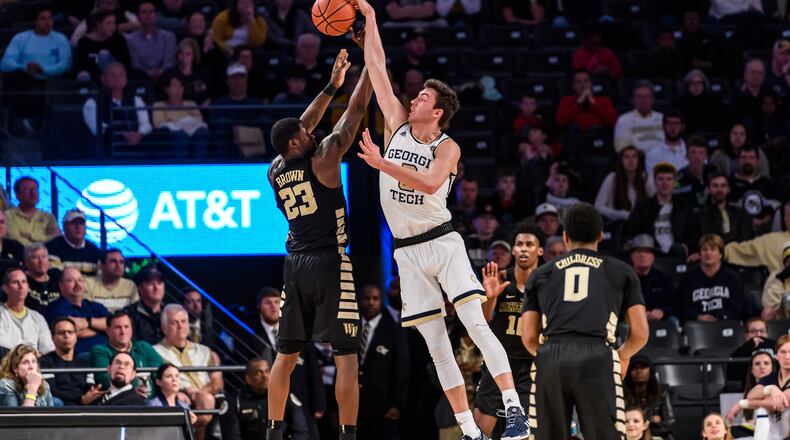It was the opening possession of the second half of Georgia Tech’s game against then-No. 9 Virginia Tech last Wednesday at McCamish Pavilion. On the left wing, Virginia Tech guard Nickeil Alexander-Walker dribbled once towards the basket, drawing forward Khalid Moore out of the Yellow Jackets’ zone to confront him while forward James Banks ranged out from the paint as an additional barrier.
Stopped, Alexander-Walker kicked the ball to the corner to guard Ahmed Hill, who had his hands ready to receive the pass and quickly released a 3-pointer from the corner. Banks took one step and leapt, extending both arms straight up.
Hill, who entered the game tied for 13th nationally with a 3-point field-goal percentage of 46.8 percent, got the shot off, but it bounced long off the rim. The Hokies, who began the game as the second-most accurate 3-point shooting team in the country (44.2 percent), retained possession and got the ball to guard Ty Outlaw, who had made 51.6 percent of his 3-point tries before the Georgia Tech game.
He had a clear look from the top of the 3-point arc but also missed, over a late challenge from guard Michael Devoe. The misses produced another stop in what proved to be arguably the Hokies’ least efficient offensive game of the season.
Virginia Tech was 5-for-27 from 3-point range, a season-low 18.5 percent, and escaped with a 52-49 win over the Jackets. Hill was 2-for-8. Outlaw was 0-for-3.
“I thought our path to breaking (Tech’s zone) was good,” Hokies coach Buzz Williams said after the game. “Obviously, we didn’t make the shots we typically make, but that’s a credit to them.”
It is a common refrain against Tech opponents.
“We did make some shots late, but I felt we had some opportunities to make some early and, unfortunately, they didn’t go in,” Wake Forest coach Danny Manning said of his team’s shooting in a 92-79 loss at McCamish on January 5.
Following Tech’s 73-59 road upset of Syracuse on Saturday, in which the Orange were 7-for-33 from 3-point range, coach Jim Boehiem observed that “I thought we got good 3-point looks, but when you’re not making them, it’s not very pretty.”
It happens a lot. Going into its Wednesday night road game at Clemson, the Jackets ranked fourth nationally in 3-point field-goal defense at 26.9 percent. It’s a complete turnaround from last season, when the Jackets were 320th (37.9 percent) and an improvement on the standards of coach Josh Pastner’s first season, when Tech was 73rd at 33 percent. Given that 3-point tries have constituted 37 percent of Tech opponent’s shots from the field, the Jackets’ ability to defend the arc is no small part of their modest success this season.
“I would say, certainly, it’s pretty hard to keep people from getting any open shots, but I think they do a very good job of limiting the quality of 3’s that you get,” Clemson coach Brad Brownell said.
The Virginia Tech and Syracuse games bore that out. It wasn’t as though the Hokies and Orange were barely getting shots off. But, typically, the Jackets were closing down the space, charging at shooters with hands up. Pastner stresses what he calls “multiple-effort plays,” in essence going full out for the duration of the shot clock.
Banks said defenders have to be desperate to contest the shot, even if the shot still gets released and may well be successful.
“But a lot of times, I want them to see all 7’6” of my wing span, all 6-10 of my body, 250 (pounds), just flying at them as fast as I can and make them have a second thought,” Banks said.
It may be that Tech’s consistency in challenging shots – as well as retreating effectively in transition, the source of many open 3-pointers – is the difference. Consider that Tech’s opponents average 5.6 makes and 20.7 attempts. If the Jackets’ understanding of the defensive scheme (which Pastner said was a shortcoming last season with a young roster) and effort to execute it were just marginally worse and opponents averaged one more successful 3-pointer per game, Tech’s percentage would be 31.7 percent. That’d be about 82nd nationally – good, but not elite.
“I think that’s a fair assessment,” Pastner said.
For a team of limited offensive means, that may be difference-making.
Brownell proposed that perhaps the consistency of the challenged shots bears influence on the open shots enabled by breakdowns.
“While I don’t think you get as many (open looks) against the really good defensive teams, then when you get one, you feel like you need to make it,” he said. “Sometimes you don’t.”
About the Author
Keep Reading
The Latest
Featured

